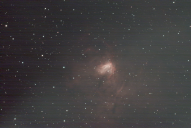Howdy, Stranger!
It looks like you're new here. If you want to get involved, click one of these buttons!
In this Discussion
stacked image artifact
for the last couple months, when I've stacked my images, I've been getting this horizontal banding pattern in my images (see attached). I tried taking new darks earlier this month, and have used flats/dark flats for the integrated image. Any idea why this is happening? It's been almost impossible to eliminate it in post-processing without severely impacting the detail, dimmer features, and contrast of the image.
Thank you,
Dave


NGC 1491.png
3120 x 2088 - 13M

Comments